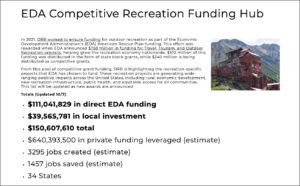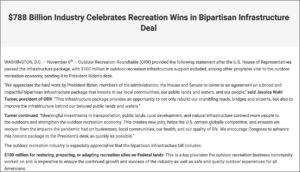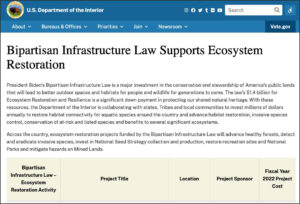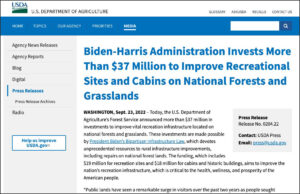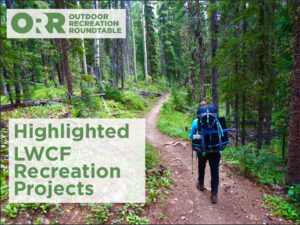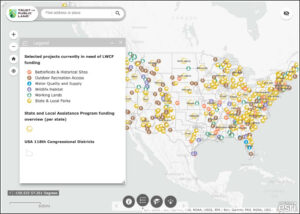High-quality recreation experiences rely on high-quality recreation infrastructure that is built to the demands of modern consumers and that can withstand the stresses of weather and climate. ORR monitors federal recreation spending to help federal land and water management agencies identify valuable recreation infrastructure investments to ensure that the critical recreation spending we achieved from the Economic Development Administration, Bipartisan Infrastructure Law, Inflation Reduction Act, and general appropriations goes to good use for the millions of Americans that enjoy public lands and waters.
Helping Guide Federal Spending
EDA
In July 2021, the U.S. Economic Development Administration (EDA) announced $750 million in dedicated funding to Travel, Tourism, and Outdoor Recreation projects as part of their American Rescue Plan Act funding. ORR advocated for the inclusion of outdoor recreation in a letter to Secretary Gina Raimondo. This was the first time that outdoor recreation has been called out as a core funding priority by the EDA.
Bipartisan Infrastructure Law
In November 2021, President Joe Biden signed into law a $1.2 trillion infrastructure package that included several important provisions for the outdoor recreation industry, including $100 million for restoring, preparing, or adapting recreation sites on Federal lands, reauthorization of the Sport Fish Restoration and Boating Trust Fund, investments in Natural Infrastructure, and $250 Million for the Forest Service’s Legacy Road and Trail Program.
Great American Outdoors Act
In 2020, the historic Great American Outdoors Act (GAOA) authorized the Land and Water Conservation Fund (LWCF) full and permanent funding and created the Legacy Restoration Fund (LRF) to address deferred maintenance on public lands and waters. ORR works with federal agencies and conservation and recreation partners to help direct LWCF and LRF dollars toward projects that guarantee recreation access for diverse user groups, support rural communities, and expand access, particularly for communities who have historically lacked or been excluded from convenient outdoor opportunities.



